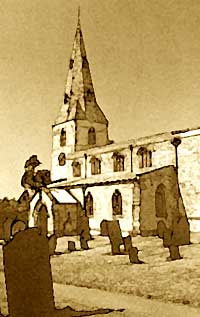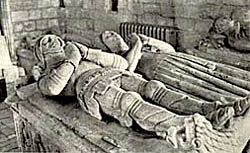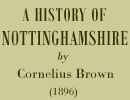< Previous | Contents | Next >
Willoughby on the Wolds
 Church of St. Mary, Willoughby.
Church of St. Mary, Willoughby.Willoughby-on-the-Wolds, nestling cosily amid the woodland scenery on the Leicestershire border, carries us back in its history to Roman times. Upon the magnificent highways which the armies of the Caesars constructed in Britain were halting-places for the troops after a day’s journey, carefully marked in the Itineraries of Antoninus; but besides these important stations, there were others denoting the mid-day stages of the soldiery when upon the march. Most of them were fortified and constructed with the solidity for which the Romans were renowned. One of these intervening stages was Willoughby, or Vernometum, on the great Foss-road which runs from Bath to Lincoln. Gough, in his additions to Camden, says, on what authority we do not know, ‘Here were the ruins of an old town called Long Billington. On the Willoughby side of the road is a tumulus called Cross Hill. The old site is in a field named Henings, or the Black Field, and was very extensive. Many coins, pavements, and other antiquities have been found here.’
Centuries ago Willoughby was robbed of its original character, and now the village stands a little distance from the Foss-road in a sheltered and picturesque locality. The antiquity of the spot is further proved by the entry in Domesday Book, and by the fact that its manors were assessed to the Danegeld. Among the owners of property here in the eleventh, twelfth, and thirteenth centuries were the Peverels, the Lovetots, Reginald de Colewyke, Sir William de Nowers, and a family taking its name from the village. Ralph Bugge, a merchant of Nottingham, and his successors also became possessed of lands at Willoughby by purchase and otherwise.

Effigies of Sir Hugh Willoughby (died 1445) and his wife, Margaret Freville in Willoughby church.
In the Church of All Saints, on the north side, is the chapel of St. Nicholas, which is filled with monuments of departed members of the great house of Willoughby. Under the window lies Sir Richard de Willoughby (son of Richard Bugge), who was an eminent lawyer in Edward I.’s line, and acquired considerable wealth, including the manors of Wollaton and Willoughby. From the Parliamentary writs he appears to have been summoned to Parliament, and in the reign of Edward II. he was elevated to the dignity of Chief Justice of the Common Pleas in Ireland. He succeeded Geoffrey le Scrope as Chief Justice on the resignation of the latter, but was displaced in 1340, though he was again reinstated in royal favour in Edward III.’s reign.
A curious adventure befell the judge in 1331. He was attacked by a Richard Fulville when on his way to Grantham, and forcibly taken into a wood, where a gang of highwaymen compelled him to pay a heavy ransom. This audacious conduct induced the adoption of stern measures for the repression of lawlessness, which was then rampant throughout the country. Sir Richard died in 1363, leaving extensive estates, and a great house situate in ‘Le Baly,’ in London.
Of the six monuments in the chapel at Willoughby, there is a fine one with figures of angels in niches. On it lies a knight in armour, with a roll or wreath round his helmet, and by his side his lady with a curious mitred head-dress.
The figure close to the north wall is that of Sir Richard de Willoughby, lying (as a card in the church says) in his robes, with a sword of justice by his side. There are other older figures in the church, one of which is that of a Crusader.
Coming to the period of the Civil War, there is a brass on the floor, on which is the following inscription: ‘Here lyes the body of Collonel Michael Stanhope, who was slain in Willoughby Field in the month of July, 1648, in the 24th year of his age, being a souldier for King Charles the First.’ This simple memoir serves to remind us of the stern conflict raging between King Charles and his Parliament which sacrificed so many young men of promise, among whom Michael Stanhope was one of the most chivalrous and daring. Mrs. Hutchinson, wife of the famous Roundhead Colonel, gives an account of the engagement at Willoughby, and local tradition affirms that the excitement was so great in the neighbourhood that the inhabitants mounted into the steeple of the church to witness the contest in the fields beneath. The battle was so important that a pamphlet was published in 1648 giving ‘an impartial and true relation of the great victory obtained through the blessing of God, after a sharp dispute, by the conjoined forces of Lincoln, Nottingham, Leicester, Derby, and Rutland, in Willoughby Fields, co. Nottingham. 4to, 1648.’ We have not a copy of the pamphlet, but from a summary of it in the catalogue of Mr. J. C. Hotten we learn that Colonel Rossiter commanded the Roundheads, and Sir Philip Monckton was at the head of the Royalists. The marches were full of incident. Finally the Royalists drew up ‘in a large beane field belonging to Willoughby,’ and the fight commenced. Rossiter lost his headpiece and received a shot through the thigh, but never said anything about it. Young Stanhope was killed, and a considerable number of Royalist prisoners taken.
In the church, near to Stanhope’s resting-place, is a cannon-ball dug up in the fatal field, and bones of the warriors who fell and who were hastily buried have occasionally been disinterred. A cross of lofty construction stood at this time in the centre of the village. It consisted of one stone five yards long, and the Cromwellian troops marked it out for destruction. The story is that they had tied ropes around it to pull it down, but their enthusiasm was so much damped by some strong beer given to them by the vicar, after he had made a long speech in defence of its innocence, that it was permitted to remain unmolested. It was left to the vandalism of a recent generation to put an end to the relic.
